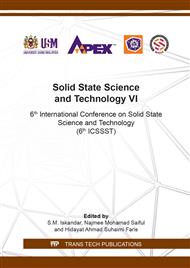[1]
Z.L. Wang, Splendid one-dimensional nanostructures of zinc oxide: a new nanomaterial family for nanotechnology, ACS Nano. 2 (2008)1987–92.
DOI: 10.1021/nn800631r
Google Scholar
[2]
P. Yang, R.Yan, M. Fardy, Semiconductor nanowire: what's next?, Nano Lett. 10 (2010) 1529–36.
DOI: 10.1021/nl100665r
Google Scholar
[3]
K.H. Muller, J. Kulkarni, M. Motskin, pH-dependent toxicity of high aspect ratio ZnO nanowires in macrophages due to intracellular dissolution, ACS Nano. 4 (2010) 6767–79.
DOI: 10.1021/nn101192z
Google Scholar
[4]
J.W. Rasmussen, E. Martinez, P. Louka, D.G. Wingett, Zinc Oxide Nanoparticles for Selective Destruction of Tumor Cells and Potential for Drug Delivery Applications, Expert opinion on drug delivery. 7(9) (2010) 1063-1077.
DOI: 10.1517/17425247.2010.502560
Google Scholar
[5]
S. Mahmud, One dimensional growth of zinc oxide nanostructures from the large micro-particle in a highly rapid synthesis, J. Alloys Cmpd. 509 (2011) 4035-4040.
DOI: 10.1016/j.jallcom.2011.01.013
Google Scholar
[6]
W. Strober, Trypan blue exclusion test of cell viability, Curr. Protoc. Immunol. 111 (2015) A3.B.1-A3.B.3.
Google Scholar
[7]
L. Shang, K. Nienhaus, G.U. Nienhaus, Engineered nanoparticles interacting with cells: size matters. Journal of Nanobiotechnology. 12 (2014) 5.
DOI: 10.1186/1477-3155-12-5
Google Scholar
[8]
B.S. Murty, P. Shankar, Baldev Raj, B B Rath, James Murday, Textbook of Nanoscience and Nanotechnology, Springer Science & Business Media, (2013).
DOI: 10.1007/978-3-642-28030-6
Google Scholar
[9]
L.C Ann, S. Mahmud, S.K.M. Bakhori, A. Sirelkhatim, D. Mohamad, H. Hasan, A. Seeni, R. A. Rahman, Characterization, Antibacterial and Bio-Compatibility of Zinc Oxide Structures, Aust. J. Basic & Appl. Sci. 8(15) (2014) 12-17.
DOI: 10.1063/1.4915219
Google Scholar
[10]
V.Ischenko, S. Polarz, D.Grote, V. Stavarache, K. Fink, and M. Driess, Zinc Oxide Nanoparticles with Defects, Adv. Funct. Mater. 15 (2005) 1945–(1954).
DOI: 10.1002/adfm.200500087
Google Scholar
[11]
T. Lozano, M. Rey, E. Rojas, S. Moya, J. Fleddermann, I. Estrela-Lopis, E. Donath, B. Wang, Z. Mao, C. Gao, A. González-Fernández, Cytotoxicity effects of metal oxide nanoparticles in human tumor cell lines, J. Phys.: Conf. Ser. 304 (2011) 012046.
DOI: 10.1088/1742-6596/304/1/012046
Google Scholar
[12]
L.C Ann, S. Mahmud, A. Seeni, S.K.M. Bakhori, A. Sirelkhatim, D. Mohamad, H. Hasan, Structural morphology and in vitro toxicity studies of nano- and micro- sized zinc oxide nanostructures, Journal Environmental Chemical Engineering. 3 (2015) 436-444.
DOI: 10.1016/j.jece.2014.12.015
Google Scholar
[13]
T. Xia, M. Kovochich, M. Liong, L. Madler, B. Gilbert, H. Shi, J.I. Yeh, J.I. Zink, A.E. Nel, Comparison of the mechanism of toxicity of zinc oxide and cerium oxide nanoparticles based on dissolution and oxidative stress properties ACS Nano. 2 (10) (2008) pp.2121-2134.
DOI: 10.1021/nn800511k
Google Scholar
[14]
W. Song, J. Zhang, J. Guo, J. Zhang, F. Ding, L. Li, Role of the dissolved zinc ion and reactive oxygen species in cytotoxicity of ZnO nanoparticles, Toxicol. Lett. 199(2010) 389–397.
DOI: 10.1016/j.toxlet.2010.10.003
Google Scholar
[15]
M Premanathan, K Karthikeyan, K Jeyasubramanian, G Manivannan, Selective toxicity of ZnO nanoparticles toward Gram-positive bacteria and cancer cells by apoptosis through lipid peroxidation, Nanomedicine: Nanotechnology, Biology and Medicine 7 (2) (2011) 184-192.
DOI: 10.1016/j.nano.2010.10.001
Google Scholar


